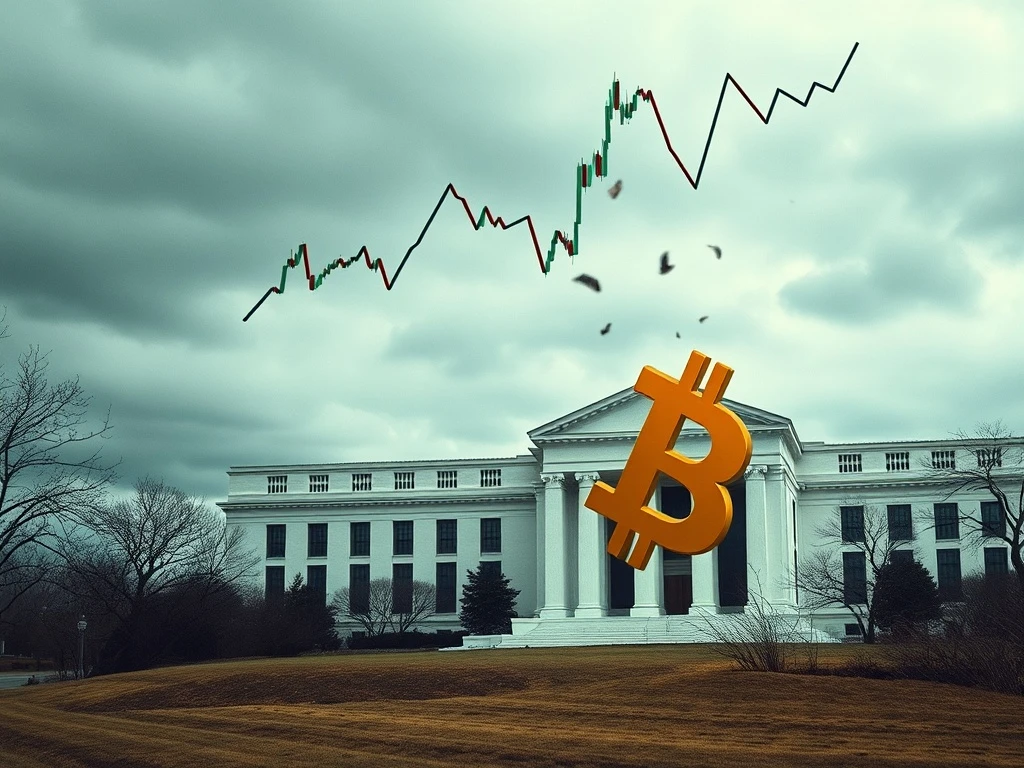Bitcoin Price Plunges: Fed Rate Cut and QT End Trigger Market Shock

The **Bitcoin price** recently saw a significant and unexpected downturn. It tumbled to $109,200, surprising many investors. This occurred despite the Federal Reserve’s recent announcement. The Fed confirmed a 0.25% **Fed interest rate cut**. It also decided to end its **Quantitative Tightening end** program. These actions typically signal a more accommodating monetary policy. Therefore, a rally might have been anticipated. However, the **crypto market reaction** proved counter-intuitive. Traders are now questioning why BTC is falling.
Understanding the Fed’s Decisions: Rate Cut and Quantitative Tightening End
The Federal Reserve’s latest policy meeting brought two major announcements. First, it implemented a 25 basis point **Fed interest rate cut**. This move lowers borrowing costs. It aims to stimulate economic activity. Second, the Fed confirmed the **Quantitative Tightening end**. It will cease shrinking its balance sheet on December 1. Quantitative Tightening (QT) involved selling off assets. This reduced the money supply. Ending QT means the Fed will no longer actively pull liquidity from the markets. Both actions usually suggest a bullish environment for risk assets like Bitcoin.
Many market participants had largely priced in a 25 basis point rate cut. A 100% consensus existed among analysts. Therefore, the cut itself offered no major surprise. However, Bitcoin’s sharp 6% drop from its Monday rally to $116,400 was more severe than anticipated. This unexpected **crypto market reaction** has prompted deeper analysis into underlying factors beyond monetary policy shifts.
Why the Bitcoin Price Fell: Analyzing Macroeconomic Headwinds
Despite the dovish Fed actions, **Bitcoin price** experienced a significant sell-off. Traders are now looking beyond the immediate policy changes. They are focusing on broader **macroeconomic headwinds**. These factors include a weakening jobs market. Persistent inflation concerns also weigh heavily. Furthermore, the longer-term impact of President Trump’s tariff war adds uncertainty. These elements create a cautious environment for investors. They might prefer safer assets over volatile cryptocurrencies.
Another significant point of discussion is the artificial intelligence (AI) sector. Investors debate whether it represents a speculation-fueled bubble. Alternatively, it could be an industry built on sound fundamentals. This uncertainty influences overall market sentiment. It can impact investor confidence in high-growth, high-risk assets. Such concerns can overshadow positive news from central banks. This explains the muted **crypto market reaction** to the Fed’s recent announcements.
Expert Insights and Future Rate Cut Expectations
Analysts had anticipated continued rate cuts. The Fed’s dot plot currently forecasts three cuts in 2025. Goldman Sachs analysts predict at least two more 25 basis point cuts. These could occur by March and June of 2026. This would place the Fed’s benchmark rate between 3% and 3.25%. Therefore, Bitcoin’s near-term price action appears counter to these expectations. This divergence highlights the complexity of current market dynamics.
Hyblock, a prominent crypto analytics company, offered valuable insight. They noted a historical pattern. FOMC announcements often lead to an initial price drop in BTC. This is typically followed by an upward movement. They stated, “Recent history has shown that the FOMC leads to a price drop in BTC, followed by a move up. This was the case in both the no rate change and rate cut (last one) scenarios.” Hyblock suggests that signs of bullish confluence, like bid-heavy orderbooks, post-dip, could present good opportunities for investors. This provides a potential outlook for the **Bitcoin price** trajectory.
Navigating the Crypto Market Reaction Beyond Fed Policy
The market consensus points towards future rate cuts. This has shifted investor focus. They are now considering what comes next, beyond these cuts. Traders are closely monitoring Fed Chair Jerome Powell’s FOMC press conference. They seek clarity on various **macroeconomic headwinds**. These include growing US job layoffs and global trade tensions. The long-term implications of these factors are significant. They are likely to influence Bitcoin’s price action more than the recent interest rate cut. That cut was, after all, largely anticipated and priced in.
The **Quantitative Tightening end** is a crucial development. It marks a shift in the Fed’s approach to its balance sheet. While not directly inflationary, it removes a deflationary force. This could, in theory, be bullish for assets like Bitcoin over time. However, immediate **crypto market reaction** reflects broader economic anxieties. These anxieties currently outweigh the positive implications of a more accommodative monetary policy. Investors are prioritizing risk assessment in a complex global economy.
Key points from the recent market activity include:
- Bitcoin’s sell-off accelerated after the Federal Reserve cut rates by 25 basis points.
- Weakness in crypto shows traders are looking at **macroeconomic headwinds** like a weakening jobs market and inflation.
- Analysts anticipate further interest rate cuts extending into 2026.
- The Federal Reserve confirmed the **Quantitative Tightening end** on December 1, halting balance sheet reduction.
This article does not contain investment advice or recommendations. Every investment and trading move involves risk, and readers should conduct their own research when making a decision.









